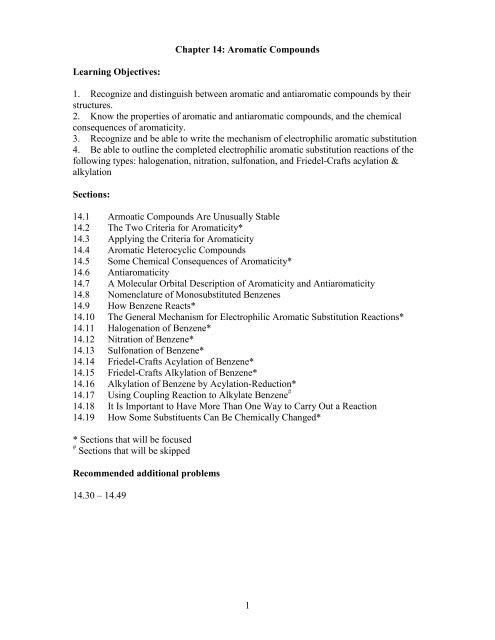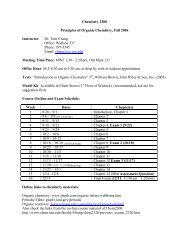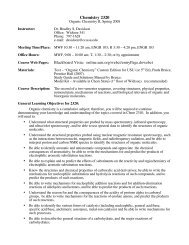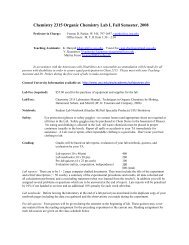1 Chapter 14: Aromatic Compounds Learning Objectives: 1 ...
1 Chapter 14: Aromatic Compounds Learning Objectives: 1 ...
1 Chapter 14: Aromatic Compounds Learning Objectives: 1 ...
You also want an ePaper? Increase the reach of your titles
YUMPU automatically turns print PDFs into web optimized ePapers that Google loves.
<strong>Chapter</strong> <strong>14</strong>: <strong>Aromatic</strong> <strong>Compounds</strong><br />
<strong>Learning</strong> <strong>Objectives</strong>:<br />
1. Recognize and distinguish between aromatic and antiaromatic compounds by their<br />
structures.<br />
2. Know the properties of aromatic and antiaromatic compounds, and the chemical<br />
consequences of aromaticity.<br />
3. Recognize and be able to write the mechanism of electrophilic aromatic substitution<br />
4. Be able to outline the completed electrophilic aromatic substitution reactions of the<br />
following types: halogenation, nitration, sulfonation, and Friedel-Crafts acylation &<br />
alkylation<br />
Sections:<br />
<strong>14</strong>.1 Armoatic <strong>Compounds</strong> Are Unusually Stable<br />
<strong>14</strong>.2 The Two Criteria for <strong>Aromatic</strong>ity*<br />
<strong>14</strong>.3 Applying the Criteria for <strong>Aromatic</strong>ity<br />
<strong>14</strong>.4 <strong>Aromatic</strong> Heterocyclic <strong>Compounds</strong><br />
<strong>14</strong>.5 Some Chemical Consequences of <strong>Aromatic</strong>ity*<br />
<strong>14</strong>.6 Antiaromaticity<br />
<strong>14</strong>.7 A Molecular Orbital Description of <strong>Aromatic</strong>ity and Antiaromaticity<br />
<strong>14</strong>.8 Nomenclature of Monosubstituted Benzenes<br />
<strong>14</strong>.9 How Benzene Reacts*<br />
<strong>14</strong>.10 The General Mechanism for Electrophilic <strong>Aromatic</strong> Substitution Reactions*<br />
<strong>14</strong>.11 Halogenation of Benzene*<br />
<strong>14</strong>.12 Nitration of Benzene*<br />
<strong>14</strong>.13 Sulfonation of Benzene*<br />
<strong>14</strong>.<strong>14</strong> Friedel-Crafts Acylation of Benzene*<br />
<strong>14</strong>.15 Friedel-Crafts Alkylation of Benzene*<br />
<strong>14</strong>.16 Alkylation of Benzene by Acylation-Reduction*<br />
<strong>14</strong>.17 Using Coupling Reaction to Alkylate Benzene #<br />
<strong>14</strong>.18 It Is Important to Have More Than One Way to Carry Out a Reaction<br />
<strong>14</strong>.19 How Some Substituents Can Be Chemically Changed*<br />
* Sections that will be focused<br />
# Sections that will be skipped<br />
Recommended additional problems<br />
<strong>14</strong>.30 – <strong>14</strong>.49<br />
1
Class Note<br />
<strong>14</strong>.1 Armoatic <strong>Compounds</strong> Are Unusually Stable<br />
H 2<br />
Ni<br />
∆H = -28.6 kcal/mol<br />
Energy<br />
+ 3H 2 cyclohexatriene<br />
(hypothetical)<br />
36 kcal/mol<br />
+ 3H 2<br />
-85.8 kcal/mol<br />
(-28.6x3)<br />
+ H 2<br />
-49.8 kcal/mol<br />
-28.6 kcal/mol<br />
2
<strong>14</strong>.2 The Two Criteria for <strong>Aromatic</strong>ity* and <strong>14</strong>.6 Antiaromaticity<br />
A. Cyclic molecule<br />
B. Every atom has p orbital<br />
C. Planar molecule<br />
D. Comply with 4n+2 rule (as compared with 4n rule)<br />
E. Consequence of aromaticity<br />
3
<strong>14</strong>.3 Applying the Criteria for <strong>Aromatic</strong>ity and <strong>14</strong>.4 <strong>Aromatic</strong> Heterocyclic<br />
<strong>Compounds</strong><br />
4
H<br />
N<br />
H<br />
N O S<br />
N<br />
O<br />
S<br />
N<br />
H<br />
N<br />
N<br />
N<br />
N<br />
H<br />
OH CH 3 CH2 CH 2<br />
H<br />
N<br />
N<br />
H<br />
N<br />
O<br />
OH<br />
N<br />
N<br />
O<br />
OH<br />
5
<strong>14</strong>.5 Some Chemical Consequences of <strong>Aromatic</strong>ity*<br />
A. Acidity of protons<br />
H<br />
H<br />
H<br />
H<br />
B. <strong>Aromatic</strong>ity on leaving group<br />
Br<br />
Br<br />
6
C. <strong>Aromatic</strong>ity on dipole moment (polarity)<br />
O<br />
O<br />
7
<strong>14</strong>.7 A Molecular Orbital Description of <strong>Aromatic</strong>ity and Antiaromaticity<br />
8
<strong>14</strong>.8 Nomenclature of Monosubstituted Benzenes<br />
Cl<br />
Br<br />
NO 2<br />
CH 3<br />
OH<br />
NH 2<br />
SO 3 H<br />
OCH 3<br />
CHO<br />
CO 2 H<br />
CH 3<br />
CHCH 3<br />
As substituent:<br />
CH 2<br />
9
<strong>14</strong>.9 How Benzene Reacts* and <strong>14</strong>.10 The General Mechanism for Electrophilic<br />
<strong>Aromatic</strong> Substitution Reactions*<br />
Addition vs. Substitution<br />
Electrophilic <strong>Aromatic</strong> Substitution vs. Nucleophilic <strong>Aromatic</strong> Substitution<br />
10
A. General Mechanism of Electrophilic <strong>Aromatic</strong> Substitution<br />
B. Reaction coordinate diagram<br />
11
<strong>14</strong>.11 Halogenation of Benzene*<br />
<strong>14</strong>.12 Nitration of Benzene*<br />
12
<strong>14</strong>.13 Sulfonation of Benzene*<br />
<strong>14</strong>.<strong>14</strong> Friedel-Crafts Acylation of Benzene*<br />
13
<strong>14</strong>.15 Friedel-Crafts Alkylation of Benzene*<br />
Result from carbocation migration<br />
<strong>14</strong>
<strong>14</strong>.16 Alkylation of Benzene by Acylation-Reduction* and <strong>14</strong>.18 It Is Important to<br />
Have More Than One Way to Carry Out a Reaction<br />
A. Clemmensen reduction<br />
B. Wolff-Kishner reduction<br />
15
<strong>14</strong>.19 How Some Substituents Can Be Chemically Changed*<br />
A. Reactions of Alkyl Substituents<br />
tert-BuO<br />
Br<br />
NBS<br />
OH<br />
peroxide<br />
or hν<br />
CN<br />
16
H 2 , Pt<br />
N<br />
H 2 , Pt<br />
O<br />
H 2 , Pt<br />
B. Oxidations of Alkyl Substituents<br />
1. KMnO 4 , heat (reflux)<br />
2. H +<br />
Na 2 Cr 2 O 7 , H + , heat<br />
17
Na 2 Cr 2 O 7 , H + , heat<br />
Na 2 Cr 2 O 7 , H + , heat<br />
Na 2 Cr 2 O 7 , H + , heat<br />
OH<br />
MnO 2<br />
(no heating needed)<br />
OH<br />
Na 2 Cr 2 O 7 , H + , heat<br />
18
C. Reduction of Nitro Group<br />
NO 2<br />
H 2 , Pt<br />
NO 2<br />
Sn, HCl<br />
NO 2<br />
Fe, HCl<br />
19
















